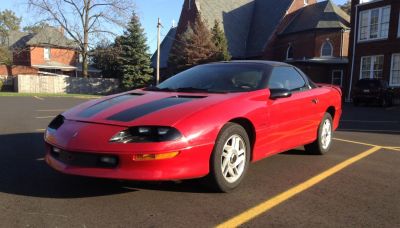 1998 Chevrolet Camaro IV (facelift 1998) Dimensions, Size & Specs
1998 Chevrolet Camaro IV (facelift 1998) Dimensions, Size & SpecsMeasurements of the 1998 Chevrolet Camaro IV, engineered for optimal performance and comfort
| Dimensions | |
|---|---|
| Length: | 4907-4915 mm193.2-193.5 in16.1-16.1 ft |
| Width: | 1882 mm74.1 in6.2 ft |
| Height: | 1300-1322 mm51.2-52.0 in4.3-4.3 ft |
| Trunk Capacity: | 365-370 liter12.9-13.1 cu ft |
| Trunk Capacity (Max): | 929-930 liter32.8-32.8 cu ft |
| Weight Specifications | |
| Curb Weight: | 1508-1605 kg3325-3538 lbs |
| Maximal permitted Weight: | 1882 kg4149 lbs |
| Tire Specifications | |
| Rims Sizes: | 17-inch rims:
|
| Tire Sizes: |
|
The Chevrolet Camaro IV Facelift, produced between 1998 and 2002, represents the fourth generation of the iconic Camaro lineup, continuing the muscle car tradition with updated styling and performance enhancements. This generation was available exclusively as a coupe, boasting a length ranging from 4907 mm to 4915 mm (193.1 to 193.3 inches), with a width between 1881 mm and 1882 mm (74.1 to 74.1 inches), and a height varying from 1300 mm to 1322 mm (51.2 to 52.0 inches). Such dimensions underscore the Camaro's sporty, low profile and aggressive stance, ideal for enthusiasts who favor a blend of sharp handling and muscular appearance. The curb weight of these models ranges from 1508 kg to 1605 kg (3324 to 3539 lbs), reflecting the robust construction and the inclusion of powerful drivetrain options, while the maximum weight capacity reaches up to 1882 kg (4149 lbs). Practicality is not overlooked in this generation—the luggage capacity offers 365 to 370 liters (12.9 to 13.1 cubic feet) of space with the seats up, expanding significantly to 929 to 930 liters (32.8 to 32.8 cubic feet) when rear seats are folded, providing ample room for gear or luggage during longer trips. The Camaro IV Facelift rode on a selection of rims sized 9J x 17, 8J x 16, and 7.5J x 16, paired with tire sizes including 215/60 R16, 275/40 R17, 245/50 R16, and 235/55 R16, catering to a range of performance and aesthetic preferences. Overall, the 1998-2002 Chevrolet Camaro IV facelift remains a compelling choice for enthusiasts seeking a classic American muscle coupe that balances size, performance, and everyday usability.
Discover the standout features that make the 1998 Chevrolet Camaro IV a leader in its class
Have a question? Please check our knowledgebase first.
The Chevrolet Camaro IV facelift, produced from 1998 to 2002, features an overall length ranging between 4907 mm and 4915 mm (193.2 to 193.3 inches). The width varies slightly from 1881 mm to 1882 mm (74.1 to 74.1 inches), while the height falls between 1300 mm and 1322 mm (51.2 to 52.0 inches). These dimensions position the Camaro within the classic American muscle coupe category, providing a low and wide stance that emphasizes sporty handling and aggressive styling.
The curb weight of the Chevrolet Camaro IV facelift from 1998 to 2002 varies between 1508 kg and 1605 kg (approximately 3323 to 3538 lbs). This weight reflects the mass of the vehicle when fully equipped and ready to drive. The weight contributes to the car’s stability and road grip but also influences acceleration, fuel consumption, and handling dynamics. Despite being relatively heavy due to its muscle car build and safety features, the Camaro balances power and weight to deliver a spirited driving experience.
The 1998 facelifted Chevrolet Camaro IV offers a luggage capacity of approximately 365 to 370 liters (about 12.9 to 13.1 cubic feet) with the rear seats in their standard upright position. When the rear seats are folded down, the luggage space expands dramatically to between 929 and 930 liters (about 32.8 cubic feet). This flexibility allows the Camaro to balance its sporty coupe character with practical storage options, suitable for weekend trips or carrying larger cargo when the rear seats are folded.
The width of the 1998-2002 Chevrolet Camaro IV facelift is approximately 1881 to 1882 mm (74.1 to 74.1 inches). This relatively wide stance gives the vehicle excellent road presence and stability at higher speeds, enhancing handling and cornering grip. On the other hand, the width can make navigating narrow city streets or fitting into tight parking spaces somewhat challenging compared to smaller cars, demanding careful maneuvering in such environments.
The height of the Camaro IV facelift ranges between 1300 mm and 1322 mm (51.2 to 52.0 inches). This low roofline contributes to a sleek, aerodynamic profile typical of muscle coupes, enhancing its sporty appearance. However, the low height can slightly affect headroom, particularly for taller drivers and passengers, and may limit upward visibility compared to taller vehicle types. The design prioritizes a low center of gravity which benefits handling performance.
Yes, the Chevrolet Camaro IV facelift generally fits into a standard residential garage. Typical garages have door widths ranging from 2438 mm to 2743 mm (96 to 108 inches), which comfortably accommodates the Camaro's width of approximately 1881 to 1882 mm (74.1 inches). The vehicle’s height of about 1300 to 1322 mm (51.2 to 52.0 inches) is well below typical garage door heights that start around 1981 mm (78 inches). Additionally, its length of around 4907 to 4915 mm (193.2 to 193.3 inches) requires a garage space longer than 5 meters or about 16 feet, which is common in many residential garages.
Compared to the third-generation Camaro (produced 1982-1992), the 1998 Camaro IV facelift is generally larger and heavier. The fourth-generation Camaro, including the facelifted models, stretches to about 4907-4915 mm in length versus the third generation, which usually measured around 4630 mm (182.3 inches). The width is also greater in the fourth generation at around 1881-1882 mm compared to roughly 1780 mm (70 inches) in the third generation. Additionally, the Camaro IV facelift's curb weight increased to approximately 1508-1605 kg from lighter earlier models due to updated safety features and structural reinforcements. This growth in size and weight aimed to improve passenger comfort, vehicle stability, and crash safety.
In comparison to contemporaries like the 1998-2002 Ford Mustang, the Chevrolet Camaro IV facelift is slightly wider but similar in length and height. The Mustang from this era measures around 4783 mm (188.2 inches) in length—just a bit shorter than the Camaro's near 4910 mm length. Width-wise, the Mustang is narrower at about 1834 mm (72.2 inches), compared to the Camaro’s 1881-1882 mm (74.1 inches). Height is similar with the Mustang around 1368 mm (53.9 inches), slightly taller than the Camaro’s 1300-1322 mm. These dimensional differences translate to the Camaro feeling a bit more substantial on the road with a lower, wider stance, emphasizing stability and aggressive styling typical of American muscle cars.
The 1998-2002 Chevrolet Camaro IV facelift features a range of rim sizes, including 9J x 17, 8J x 16, and 7.5J x 16 inches, which cater to different trims and performance packages. Tire sizes paired with these rims vary accordingly, commonly including 215/60 R16, 275/40 R17, 245/50 R16, and 235/55 R16. These tire and rim sizes provide a balance between sporty performance and ride comfort, with wider tires helping the Camaro achieve better grip and handling characteristics essential for a muscle coupe.
The Chevrolet Camaro IV facelift (1998-2002) is the fourth generation of this iconic muscle car, receiving styling updates primarily to the front and rear fascias that refreshed its appearance without drastic changes to its fundamental design. Under the hood, it was offered with a variety of V6 and V8 engines, including a 3.8-liter V6 and a 5.7-liter V8 producing substantial horsepower for spirited performance. It maintained a rear-wheel-drive layout and offered a choice of manual or automatic transmissions. Interior improvements emphasized driver ergonomics and comfort while retaining the sporty feel. The facelift enhanced safety features and improved build quality. Overall, it balanced classic muscle car appeal with modern refinements for its era.
Discover similar sized cars.

| Production: | 1982-1992 |
|---|---|
| Model Year: | 1982 |
| Length: | 4833 mm190.3 in |
| Width: | 1838 mm72.4 in |
| Height: | 1264 mm49.8 in |

| Production: | 2023-present |
|---|---|
| Model Year: | 2023 |
| Length: | 4959-4966 mm195.2-195.5 in |
| Width: | 2113 mm83.2 in |
| Height: | 1353 mm53.3 in |

| Production: | 1992-1998 |
|---|---|
| Model Year: | 1993 |
| Length: | 4907 mm193.2 in |
| Width: | 1883 mm74.1 in |
| Height: | 1303 mm51.3 in |

| Production: | 1970-1981 |
|---|---|
| Model Year: | 1970 |
| Length: | 4775-5020 mm188.0-197.6 in |
| Width: | 1892 mm74.5 in |
| Height: | 1270-1300 mm50.0-51.2 in |
